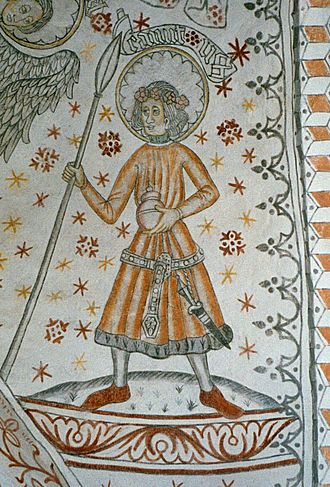Saint Knut's Day facts for kids
Quick facts for kids Saint Knut's Day |
|
|---|---|

Canute Lavard
|
|
| Also called | tjugondag jul, tjugondag Knut, knutmasso |
| Observed by | Sweden, Finland, Estonia |
| Date | 13 January |
| Frequency | annual |
Saint Knut's Day is a special holiday celebrated in Sweden and Finland on January 13. It's also known by its Swedish names, Swedish: tjugondag jul (meaning 'twentieth-day Christmas') or tjugondag Knut ('twentieth-day Knut'). In Finland, it's called Finnish: nuutinpäivä. This day marks the end of the Christmas season. A fun tradition is taking down Christmas trees and eating all the candies and cookies that decorated them! In Sweden, this celebration is often called a Knut's party, or julgransplundring, which means 'Christmas tree plundering'. The holiday is named after a Danish prince, Canute Lavard.
Contents
What is Saint Knut's Day?
Saint Knut's Day is a traditional festival that wraps up the long Christmas season. It's a time for families and friends to gather. They often enjoy the last bits of Christmas treats. Many people also take down their Christmas decorations on this day. It's a way to say goodbye to the festive period.
How the Day Got Its Name
The holiday is named after Canute Lavard, a Danish duke. He lived a long time ago, in the 1100s. Canute Lavard died in a conflict with his cousin, Magnus Nilsson, in 1131. After his death, there was a big fight for power in Denmark. Because of this, Canute was later declared a saint. His special day, or name day, was first set for January 7.
Why the Date Changed
January 7 was already close to another important holiday called Epiphany. Epiphany is sometimes called the "thirteenth day of Christmas." To avoid confusion, Saint Knut's Day was moved. In 1680, the date was officially changed to January 13. This new date became known as the 'twentieth day of Knut' or the 'twentieth day of Christmas'.
Saint Knut's Day in Finland
In Finland, Saint Knut's Day is called nuutinpäivä. A unique tradition on this day involves people dressing up. They are called nuuttipukki, which means 'Knut's goat'. These people used to dress in funny costumes. They would wear an upside-down fur jacket and a mask. They also often had horns, like a goat.
The Nuuttipukki Tradition
Long ago, the Nuuttipukki characters were a bit scary. They would visit houses and ask for food or drinks. If they didn't get anything, they might play a trick! There's an old Finnish saying about this: Hyvä Tuomas joulun tua, paha Knuuti poijes viä. This means 'Good [St.] Thomas brings Christmas, evil Knut takes [it] away.'
Today, the Nuuttipukki tradition is much friendlier. It's mostly children who dress up now. They go from house to house, and it's a happy meeting. This tradition is still popular in some parts of Finland. You can especially see it in areas like Satakunta and on the Åland Islands.
Saint Knut's Day in Sweden
In Sweden, Saint Knut's Day marks the very end of the Christmas and holiday season. It's a time for one last Christmas celebration. The main event is often called a Knut's party.
The Christmas Tree Plundering
During a Knut's party, families take down their Christmas trees. A fun part of the tradition is dancing around the tree. After the dancing, everyone gets to "plunder" the tree. This means they eat all the candies, cookies, and other treats that were used as decorations. This feast is mostly for children today. It's a joyful way to say goodbye to Christmas until next year.

